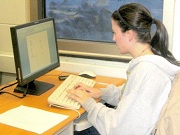|
Sections "B. ORGANIZING" and "C. REVISING" Activities Page
(See also "Activities
for Groups.")
---
Activities for Sections
"B" and "C"
Activity 1. Find an old paper to revise.
Find (or think of) an old paper of yours, preferably from a few years
earlier. How would you fix it now?
Activity 2. Write your friends' conversation.
Listen to your friends (or to yourself). Write
down several instances of what was said and how you would write it correctly if
placing it in a formal paper.
Activity 3. Interview a friend. Do "2"
above, but as an interview of one friend or family member.
Activity 4. Write several made up
conversations. Pretend you are talking with your closest friend or
relative and write down something you might say to that person. Then rewrite it,
according to how you would say it to a stranger. Then write a third version
as if you were preparing a paper or, perhaps, a public speech.
Activity 5. Use "circle sentencing" on varied
sentence lengths. Practice making varied sentence lengths using circle
sentencing. Do this as a whole class:
-
First, everyone
should get out a sheet of lined paper, write "1. Once upon a time,
______________," and complete the sentence in an interesting, silly, or unusual
way. Second, everyone should pass this paper to the next person clockwise
or in his/her row, read the new paper in front of her, write "2. __[long sentence]__," and complete the blank with something
that ties in with #1 and is a long sentence. Third, everyone
should pass his or her paper to the next person, read the new paper in front
of her,
"3. __[short sentence]__," and complete the blank with
something that ties in and is a short sentence. Continue to
pass the papers, add new sentences to each sheet, one at a time, and vary
the length of the sentence each time. In this manner, sentences
"2," "4," "6," etc. will be long
sentences, and sentences "3," "5," "7," etc.
will be short sentences.
-
Keep the sentences
circling for ten to twenty-five minutes. Then add a final, concluding
sentence or two of any kind. Then read some of the results. If
you wish, choose just a few for your instructor to read: mark the paper in
front of you using a scoring system of 4 stars (****; 4 is very interesting,
3 good, 2 okay, 1 not interesting).
Activity 6. Use pairs to practice comma rules. Break into pairs. Both of you should get out a pen or pencil and paper. Throughout this
exercise, both of you will write down the results that you decide on together. (For
example, you will decide on a sentence for #2 below: even though it is the same sentence
that you choose together, both of you should write it individually on your own paper.)
Choose a serious subject or news event about which you both feel strongly and believe
similarly. Develop a sentence that states the subject you have chosen and how you feel
about it. Both of you then should write this sentence, each of you individually, on your
own paper.
Next, each of you should write the letter "(a.)." Then look at
the comma rules in the "Punctuation" chapter's "Common
Comma Rules." After the "(a.)" you have written, add a
sentence that goes along with what you wrote in the previous sentence;
however, in this "(a.)" sentence, you must use a comma according to the
comma rules as described in
Comma Rules A. This sentence will be a continuation of your discussion of
your serious subject. Once you have developed a sentence using Comma Ryule A,
then each of you should write it down individually on your own piece of paper.
In your sentence on your papers, circle the comma or commas that you have used
for Comma Rule A.
Next, continue by writing the letter "(b.)" and making up a third sentence
using the Comma Rule B. Each of you then should write down this sentence on
your own paper. Circle the comma(s) you have inserted because of Comma Rule B.
Continue on with Comma Rules C, D, E, and F in the same way, writing a sentence
for each and circling the comma(s) in each.
Add a brief ending of one or two sentences.
If there is time, one individual each from several of the pairs may want to read his or
her results, and that person should read aloud the commas—by saying "comma"—whenever
the person sees a comma on the page.
---
Find more activities for groups and classes in the
Home Page section's
General Activities for Groups.
---
Return to top.
|

